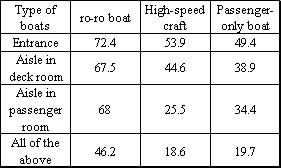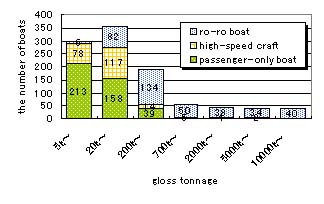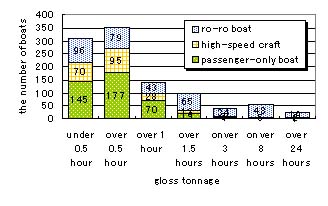| To Solve the Problems for a Barrier-free Passenger Boat May 2001, by Keiko Miyazaki 
 Introduction
IntroductionBarrier-free facilities are going to be equipped even in Japan. Passenger boats also need to be barrier-free. Transportation Accessibility Improvement Law is enacted in Japan in 2000. Thus the ship, more than five tons needs to follow the regulations. National Maritime Research Institute has made database of barrier-free facilities on passenger boats based on the research of 1,088 domestic passenger boats. We explain the present situation of domestic passenger boats and problems toward barrier-free passenger boats.
 The Present Situation of Passenger Boats
The Present Situation of Passenger BoatsFigure 1 explains the number of passenger boats based on their gloss tonnage in Japan. A high-speed craft means its speed is over 22 knots. As small ships which tonnage are under 699ton account for large percentage in domestic passenger boats, those small passenger boats should be applied barrier-free technical guideline to promote whole domestic accessibility. Figure 2 shows the number of passenger boats based on their voyage time in Japan. As those statistics express, Japanese passenger boats are so diverse that they need appropriate barrier-free facilities and layouts. The present situation of Barrier-free equipment on domestic passenger boats is the following. The number of boats, which gloss tonnage are over 20ton, are equipped with both a toilet/toilets for a wheelchair user and an elevator/elevators is 25. It is 4.8% among the boats that gloss tonnage are over 20ton and have more than one deck. The number of boats, which gloss tonnage are over 20ton, are equipped with a toilet/toilets for a wheelchair user is 80. It is 11.7% among the boats that gloss tonnage are over 20ton and have any kinds of toilet. The number of boats that have a mobile facility/facilities such as an elevator or an escalator is 68. It is 14.8% among the boats in where passengers need to transfer between decks. Those figures show there is room for improvement for barrier-free boats.
A wheelchair user needs a width of an isle at least 800mm to go through. Table 1 explains percentages of each type of passenger boats that have each width of the following items is over 800mm and all widths of them are over 800mm. The items are a width of an entrance of a deck room, a width of an aisle from the entrance to a passenger room and a width of an aisle in a passenger room. A wheelchair user goes through an entrance in over half of the passenger boats at the point of its width. But an entrance of boats has a sill to avoid to get into water. To determine whether a wheelchair user can get into a boat easily needs a further study. Generally internal mobility of the high-speed crafts is not good.
have over 800mm width of an aisle (%) 
 Problems of the Present Passenger Boats toward Barrier-free Ships
Problems of the Present Passenger Boats toward Barrier-free Ships
We summarize problems to be solved to realize a barrier-free passenger boat as the following.
 Studies for Barrier-free Passenger Boats in National Maritime Research Institute
Studies for Barrier-free Passenger Boats in National Maritime Research Institute
National Maritime Research Institute engages the following studies to solve the problems that are mentioned above.
We also have the following plans.
| ||
|
[ Barrier-free HOME ] [ NMRI HOME ] |
||
|
| ||
| Contact: okuzumi@nmri.go.jp |
 Figure 1 The number of passenger boats based on their gloss tonnage
Figure 1 The number of passenger boats based on their gloss tonnage Figure 2 The number of passenger boats based on their voyage time
Figure 2 The number of passenger boats based on their voyage time